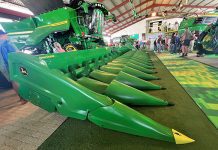The obsession with the Big Five sees Africa inundated with tourists determined to see them live in the game reserves. But there are many equally fascinating small creatures that deserve as much, if not more attention and respect. Abré J Steyn discusses his ‘Small Five’.
“Small things amuse small minds,” my grandfather used to say. He was wrong. Since childhood I have been fascinated by little things – butterflies, tadpoles, lizards, minnows, birds and mice. Only much later did my interest in the big ones develop – giant bullfrogs, pythons, eagles, Great White sharks, rhinos and elephants. There’s so much more to learn about life’s smallest that the biggest part of nature is missed by those who pass them by.
Thousands of people come halfway around the world to see our Big Five – the elephant, rhinoceros, buffalo, leopard and lion. Although they interest me, I’m even more intrigued by some of their miniatures – the elephant shrew, rhinoceros beetle, buffalo weaver, leopard tortoise and ant lion, but because I’ve already written about the latter, I’ll replace it with the lion fish.
Few people have ever seen an elephant shrew, of which there are quite a number of species endemic to Africa. They’re fascinating, dainty, insectivorous, mouse-like mammals with elongated, highly mobile, trunk-like snouts, long hind legs and huge, black eyes. They mainly feed on ants and termites, which they catch with their long, thin red tongues that can even reach over their heads to clean their fur.
Elephant shrews live in a variety of habitats, but all use permanent dens from which fixed paths radiate in all directions. Although they walk on all fours, they always flee with the same 70cm-long hops, leaving plate-sized bare patches behind them on their paths, always in the same spot. When scared, they sound an alarm by drumming audibly or producing a “snoring” sound by vibrating their hind feet on the ground.
The second of the Small Five, the rhinoceros beetle, is in fact one of the scarab beetles, which were so revered by the ancient Egyptians. They all have broad and often scalloped front legs for digging underground, from where, in the eyes of the old masters of the Nile, they miraculously reappeared after hibernation, just as the Egyptians believed their own mummified bodies would one day rise again from the underworld. They include dung and fruit beetles, some of which are the bulkiest and strongest insects alive.
While most male rhinoceros beetles have horns for fighting, females don’t and are often confused with dung beetles. They have characteristic C-shaped larvae, some of which walk upside-down and are often found in compost heaps.
Although the red-billed buffalo weaver is one of the Small Five, it’s the largest of the 35 South African species of the family Ploceidae, to which weavers and sparrows belong. It looks more like a starling in size and colour, but its bright orange legs and bill distinguish it as weaver. It occurs only in the northern bushveld areas of the country, where it often builds nests in baobabs or powerline pylons – large, untidy, communal nests of sticks and thorny branches, second only in size to those of the social weavers of the Kalahari. Although they appear to be haphazard, they’re craftily and durably designed with several escape routes. The crude and confusing appearance also makes it difficult for snakes to gain access.
The old big game hunters created the mythical Big Five because it was so dangerous to hunt them. On my list of the Small Five, the only dangerous species is the incredibly beautiful lion fish, whose dorsal and pectoral fins have hollow spines. Each has a gland near its base which can inject extremely toxic venom into anyone foolish enough to touch them.
For their size, they probably have the largest pectoral fins of any fish, using them to entrap the shrimps or small fish on which they feed against rocks, coral or other underwater structures.
Where the leopard is the smallest of the Big Five, some weighing as little as 40kg, the leopard tortoise, in contrast, is the heaviest member of the Small Five and the fourth largest tortoise in the world. Adults often weigh between 15kg and 18kg, while giants of over 50kg have been recorded. They’re remarkably adaptable and have the widest distribution of all African land tortoises, occurring from Cape Point to Sudan, from semi-desert to areas with over 1 400mm of rainfall per year. They’re truly ancient creatures – one of the oldest vertebrates alive. They walked the earth even before the dinosaurs existed.
We’ve merely skimmed over these five small species. They are, however, like five tiny grains of sand in an enormous sand dune of diverse and complex living creatures on this planet. We included only one species of the enormous insect multitude, of which not even half of all species are known to science. Then there’s the multitude of other invertebrates and plants, each with a remarkable and fascinating life.
Consider this – insects outnumber all other life forms together and there are more than 20 species of them for each species of vertebrate. This includes all mammals, birds, reptiles, amphibians and all the fish in all the world’s oceans. This makes our extreme obsession with a few big species quite absurd.
Grandpa was definitely wrong. Small things don’t necessarily amuse small minds. On the contrary, they often broaden one’s mind to see the big picture. To study them brings us to a point where we can be stripped of all our human arrogance and be humble again before the handiwork of our Almighty Creator.
Contact Abré J Steyn on 083 235 4822 or e-mail [email protected]. |fw








